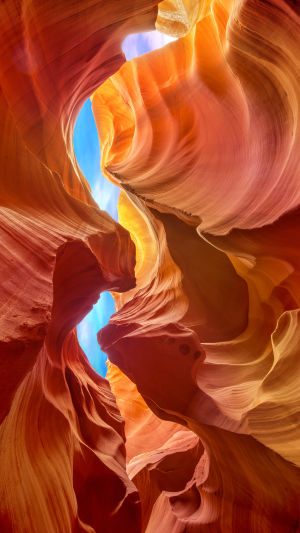Antelope Canyon, one of the most renowned slot canyons in the world, is a popular photography spot. It is located in the northern region of Arizona, USA, and the nearest city is Page, which belongs to the Navajo Aboriginal Reserve.
The older generation of Navajo once regarded this place as a habitat for meditation and communication with the Great Spirit. In the past, it was the habitat of pronghorn antelope, and thus it was called Antelope Valley. It has now been listed as one of the ten most peculiar landforms on earth.
Antelope Canyon is divided into two separate parts: Upper Antelope Canyon and Lower Antelope Canyon. It is a famous slit-shaped canyon located in the Arizona desert and is a dry riverbed all year round. Its appearance resembles a fine ditch where running water washes out the sand on the surface.
The canyon's formation took hundreds of thousands, or even millions of years, as the corners and sharp edges of the mountain peaks were gradually smoothed by the power of time, leaving behind the magnificent sight that tourists can witness today.
When one descends into the valley, the rocky surface of the valley wall appears to be carefully polished, and the laminae flow along the rock wall, resembling waves that were frozen in this canyon thousands of years ago. Sunlight enters from the top of the canyon, creating stunning colors.
The most representative feature of Antelope Canyon's scenery is the variety of natural colorful rocks. If one just looks at the pictures without knowing it is natural scenery, many may think it is a wonderful painting or the result of modern technological transformation.
Antelope Valley is illuminated by natural light entering the cave through the cracks in the top rocks, causing the colors in the valley to change with the intensity of the light. These colors range from yellow to orange, pink, reddish brown, purple, and blue.
The valley appears orange-pink in the summer and bluish-purple in the winter. At noon, there is likely to be strong sunlight directly hitting the bottom of the valley, producing light columns, and the rocks appear very colorful.
Once one enters the bottom of the canyon, the road is not unimpeded, but very winding and irregular. Additionally, without a local guide, there is little chance to enter the canyon by following the sun's rays, making it impossible for tourists to find the right way.
Compared to Lower Antelope Canyon, Upper Antelope Canyon is more suitable for photography. The most famous feature here is the dreamy beam of light that shoots from top to bottom into the valley.
The best viewing time is from 11 am to 3 pm every day. At noon, the sun's rays shine directly into the valley, creating a gently colored sandstone with light, dreamlike fine dust.
Lower Antelope Canyon is mysterious and dangerous. Visiting it requires timing to avoid the rainy season, so it is only open for almost three months of the year.
Tourists descend into the canyon step by step along the fixed iron ladder and may use ropes in the middle. When they reach the bottom of the canyon, the real surprise begins.
There are no artificial lights in Antelope Canyon! All the dreamy colors are the result of repeated refraction of natural light through rock textures. If one is not immersed in the environment, it is difficult to believe that these ever-changing lights come from a single natural light source.





